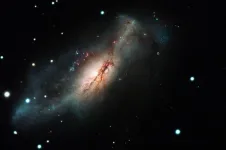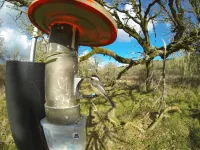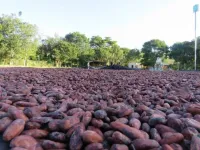(Press-News.org) An international team of astronomers has observed the first example of a new type of supernova. The discovery, confirming a prediction made four decades ago, could lead to new insights into the life and death of stars. The work is published June 28 in Nature Astronomy.
"One of the main questions in astronomy is to compare how stars evolve and how they die," said Stefano Valenti, professor of physics and astronomy at the University of California, Davis, and a member of the team that discovered and described supernova 2018zd. "There are many links still missing, so this is very exciting."
There are two known types of supernova. A core-collapse supernova occurs when a massive star, more than 10 times the mass of our sun, runs out of fuel and its core collapses into a black hole or neutron star. A thermonuclear supernova occurs when a white dwarf star -- the remains of a star up to eight times the mass of the sun -- explodes.
In 1980, Ken'ichi Nomoto of the University of Tokyo predicted a third type called an electron capture supernova.
What keeps most stars from collapsing under their own gravity is the energy produced in their central core. In an electron capture supernova, as the core runs out of fuel, gravity forces electrons in the core into their atomic nuclei, causing the star to collapse in on itself.
Evidence from late spectrum
Supernova 2018zd was detected in March 2018, about three hours after the explosion. Archival images from the Hubble Space Telescope and Spitzer Space Telescope showed a faint object that was likely the star before explosion. The supernova is relatively close to Earth, at a distance of about 31 million light years in galaxy NGC2146.
The team, led by Daichi Hiramatsu, graduate student at UC Santa Barbara and Las Cumbres Observatory, collected data on the supernova over the next two years. Astronomers from UC Davis, including Valenti and graduate students Azalee Bostroem and Yize Dong, contributed a spectral analysis of the supernova two years after the explosion, one of the lines of evidence demonstrating that 2018zd was an electron capture supernova.
"We had a really exquisite, really complete dataset following its rise and fade," Bostroem said. That included very late data collected with the 10-meter telescope at the W.M. Keck Observatory in Hawaii, Dong added.
Theory predicts that electron capture supernovae should show an unusual stellar chemical spectrum years later.
"The Keck spectra we observed clearly confirm that SN 2018zd is our best candidate to be an electron capture supernova," Valenti said.
The late spectrum data were not the only piece of the puzzle. The team looked through all published data on supernovae, and found that while some had a few of the indicators predicted for electron capture supernovae, only SN 2018zd had all six: an apparent progenitor star of the Super-Asymptotic Giant Branch (SAGB) type; strong pre-supernova mass loss; an unusual stellar chemical spectrum; a weak explosion; little radioactivity; and a neutron-rich core.
"We started by asking 'what's this weirdo?' Then we examined every aspect of SN 2018zd and realized that all of them can be explained in the electron-capture scenario," Hiramatsu said.
Explaining the Crab Nebula
The new discoveries also illuminate some mysteries of the most famous supernova of the past. In A.D. 1054 a supernova occurred in the Milky Way. According to Chinese records it was so bright that it could be seen in the daytime for 23 days, and at night for nearly two years. The resulting remnant -- the Crab Nebula -- has been studied in great detail. It was previously the best candidate for an electron capture supernova, but this was uncertain partly because the explosion happened nearly a thousand years ago. The new result increases the confidence that the event that formed the Crab Nebula was an electron capture supernova.
"I am very pleased that the electron capture supernova was finally discovered, which my colleagues and I predicted to exist and have a connection to the Crab Nebula 40 years ago. This is a wonderful case of the combination of observations and theory," said Nomoto, who is also an author on the current paper.
INFORMATION:
The research is part of the Global Supernova Project, led by Professor Andrew Howell at UCSB and Las Cumbres Observatory. Additional co-authors are: Curtis McCully and Jamison Burke, Las Cumbres Observatory and UCSB; Jared Goldberg and Chengyuan Xu, UCSB; Schuyler Van Dyk and Gagandeep Anand, California Institute of Technology; Keiichi Maeda, Kyoto University; Takashi Moriya, National Astronomical Observatory of Japan; Nozomu Tominaga, Konan University, Kobe, Japan; Griffin Hosseinzadeh, Center for Astrophysics, Harvard & Smithsonian; Iair Arcavi, Tel Aviv University, Israel; Peter Brown, Texas A&M University; Jennifer Andrews, Christopher Bilinski, G. Grant Williams, Paul Smith, Nathan Smith and David Sand, Steward Observatory, University of Arizona; Alexei Filippenko, UC Berkeley; Melina Bersten and Gastón Folatelli, Instituto de Astrofísica de La Plata and Universidad Nacional de La Plata, Argentina; Patrick Kelly, University of Minnesota; Toshi- hide Noguchi, Noguchi Astronomical Observatory and Koichi Itagaki, Itagaki Astronomical Observatory, Japan. The work was partly supported by grants from the National Science Foundation and NASA.
NEW YORK, NY (June 28, 2021)--In the first analysis of its kind, researchers at Columbia University Vagelos College of Physicians and Surgeons and several other institutions have linked distinct patterns of genetic mutations with obsessive-compulsive disorder (OCD) in humans.
The work, published online June 28 in Nature Neuroscience, confirms the validity of targeting specific genes to develop new OCD treatments and points toward novel avenues for studying this often debilitating condition.
OCD, which affects 1% to 2% of the population, often runs in families and genes are known to play a large role in determining who develops the disease. However, the identity of many OCD genes remains unknown.
"Many neurological diseases are ...
Slow earthquakes are long-period earthquakes that are not so dangerous alone, but are able to trigger more destructive earthquakes. Their origins lie in tectonic plate boundaries where one plate subsides below another. Though the causal mechanism is already known, there has been a lack of data to accurately model the life cycle of slow earthquakes. For the first time, researchers use deep-sea boreholes to gauge pressures far below the seafloor. They hope data from this and future observations can aid the understanding of earthquake evolution.
The surface of the Earth lies upon gargantuan ...
New York, NY--June 28, 2021--Predicting what someone is about to do next based on their body language comes naturally to humans but not so for computers. When we meet another person, they might greet us with a hello, handshake, or even a fist bump. We may not know which gesture will be used, but we can read the situation and respond appropriately.
In a new study, Columbia Engineering researchers unveil a computer vision technique for giving machines a more intuitive sense for what will happen next by leveraging higher-level associations between people, animals, and objects.
"Our algorithm is a step toward machines being able to make better predictions about human behavior, and ...
Sixteen of the 146 health-related All-Party Parliamentary Groups (APPGs) in the Houses of Parliament (UK) received over a £1 million in payments from 35 pharmaceutical companies between 2012-2018 according to a new study.
The researchers behind the analysis from the University of Bath's Centre for the Analysis of Social Policy suggest their findings reveal a worrying lack of transparency over payments received and potential conflicts of interests towards public policy.
Through their research they extracted details from 6,624 entries about funding ...
Experts estimate more than 6 million Americans are living with Alzheimer's dementia. But a recent study, led by the University of Cincinnati, sheds new light on the disease and a highly debated new drug therapy.
The UC-led study, conducted in collaboration with the Karolinska Institute in Sweden, claims that the treatment of Alzheimer's disease might lie in normalizing the levels of a specific brain protein called amyloid-beta peptide. This protein is needed in its original, soluble form to keep the brain healthy, but sometimes it hardens into "brain stones" or clumps, called amyloid plaques.
The study, which appears in the journal EClinicalMedicine (published by the Lancet), comes on the heels of the FDA's conditional approval of a new medicine, aducanumab, that ...
CORVALLIS, Ore. - Oregon State University researchers have some good news for the well-meaning masses who place bird feeders in their yards: The small songbirds who visit the feeders seem unlikely to develop an unhealthy reliance on them.
"There's still much we don't know about how intentional feeding might induce changes in wild bird populations, but our study suggests that putting out food for small birds in winter will not lead to an increased dependence on human-provided food," said Jim Rivers, an animal ecologist with the OSU College of Forestry.
Findings from the research, which looked at black-capped chickadees outfitted with radio frequency identification tags, ...
New York, NY (June 28, 2021) - Patients with a type of blood cancer called multiple myeloma had a widely variable response to COVID-19 vaccines--in some cases, no detectable response--pointing to the need for antibody testing and precautions for these patients after vaccination, according to a study that will be published in Cancer Cell this week.
Mount Sinai researchers found that multiple myeloma patients mount variable and sometimes suboptimal responses after receiving the Pfizer-BioNTech or Moderna COVID-19 vaccines. Almost 16 percent of these patients developed no detectible antibodies after both vaccine doses. These findings may be relevant to other cancer patients undergoing treatment and to immunocompromised patients.
"This study ...
Did you know chocolate comes from cocoa beans grown in some of the most biodiverse tropical landscapes on the planet? The cocoa tree (Theobroma cacao) is farmed within biodiversity hotspots of West Africa, South America, and Southeast Asia. Cocoa was traditionally grown under a canopy of native trees that provided habitat for birds and other wildlife. However, pressure to increase cocoa production has pushed many farmers to clear forest and eliminate the shade trees on their farms.
An estimated 2-3 million hectares of tropical forest were converted to cocoa from 1988-2008 with severe consequences for biodiversity. Unsustainable cocoa monocultures (agricultural ...
Multi-business firms have flexibility advantages over single-business rivals because they have the option to redeploy resources across businesses. This flexibility, it has been assumed without empirical evidence, is purported to inspire quicker exits from markets.
A 2017 survey revealed that 70 percent of corporate executives expected to make at least one divestment in the subsequent two years, with the primary motive being strategic realignment of portfolios as non-core assets are shed. A large number of academic studies have established that parent firms tend ...
Imagine having feelings of distress and negativity at some point as you are going about your day. Then imagine feeling that way every day, for almost 21 days. Lesbian, gay, bisexual, transgender and queer youth don't have to imagine having negative feelings at some point throughout the day for an extended period of days. A new study from American University reveals just how pervasive emotional distress is related to stigma around sexual orientation.
"Although we know that LGBTQ youth experience bullying, discrimination, and microaggressions during adolescence, we don't know how prevalent these experiences ...




